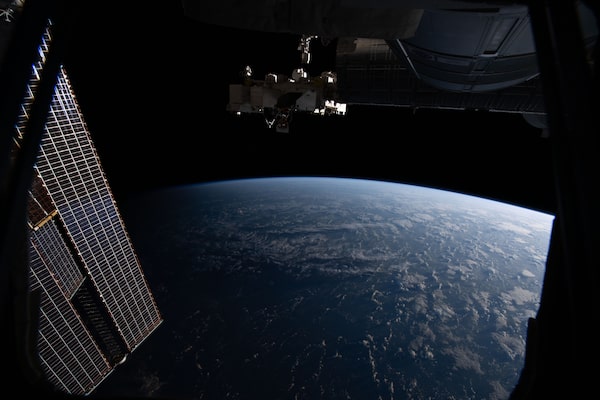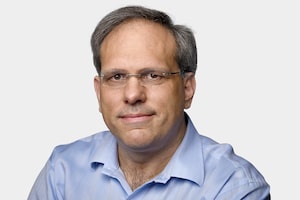Canadian businessman-turned-space station crewmember Mark Pathy waves to the camera during an interview with The Globe and Mail.Handout
Mark Pathy, a Canadian businessman and philanthropist, arrived at the International Space Station last Saturday as part of the first fully commercial flight to the orbiting laboratory. Mr. Pathy, who is chief executive and chairman of the Montreal-based investment company Mavrik, said he has paid about US$50-million to be a part of the 10-day mission, regarded as a milestone in the development of private space flight. The expedition, which includes two other paying customers and is led by a former NASA astronaut, was organized by Axiom Space of Houston.
Mr. Pathy, who previously said he hopes to prove his trip is “more than about being on a joyride,” has partnered with several Canadian universities as well as the Montreal Children’s Hospital and the Royal Canadian Geographic Society to conduct experiments while in space and participate in educational outreach.
On Friday, he spoke with The Globe and Mail from orbit to offer his impressions of the experience.
Was has been the coolest thing so far about going to space?
One of the coolest things by far was the initial launch. After all that training and anticipation and the multiple delays … to finally be in that seat and to feel the engine ignite and the thrust start to push us up off the launch pad. And then, a few minutes later, to reach space. That was unbelievable.
What was going through your mind at that moment?
I wasn’t really nervous. I was just looking forward to it. And then when it started, it was actually much smoother than I thought – I thought it was going to be intense, maybe a bit violent, but it was actually very smooth and just such a feeling of excitement and exhilaration and utter joy, really.

Photos from Mark Pathy taken from aboard Axiom-1.Mark Pathy
What was it like when you arrived at the space station?
We came in through the zenith hatch, which means coming in from the ceiling, so it was a bit disorienting. But we had such a nice, warm welcome from all the crew … it was pretty emotional.
How have you adjusted to life in zero gravity?
No matter how much you train, you know you can’t simulate zero gravity on Earth, so you never know quite what that’s going to feel like. I guess I was surprised. It was certainly a new feeling. There’s no up or down, every wall is the floor, or the ceiling, it doesn’t really matter. I had a bit of nausea for the first two days. It was exciting to be here, but after getting over that, it was even better.
What is your day-to-day routine like?
We all have slightly different schedules because we have different payloads to work on. The anticipation was that I would have about nine-hour days and I’ve had some days that have been a bit easier. The day before yesterday was a 14-hour day. So the workload is pretty heavy and it’s not necessarily always the same. The main plan is to get up at 6, have breakfast by 7:15. We do our morning briefing conference at 7:30 with the ground – the whole crew does – and then we get to work.
What has been a highlight of the science and technology experiments you’ve worked on so far?
Probably the most exciting has been the first-ever demonstration of two-way “holoportation” between the ISS and Earth. It’s an augmented-reality application where I wear what’s called a “hololens” that lets me see everything that’s in my environment, but I can also see a three-dimensional image of someone on the ground. So it almost seems like they’re right there with me, and they see the same thing down on Earth.
Who was at the other end of the conversation?
There were a few people. I spoke with retired Canadian astronaut Dave Williams, who has been my science lead for this mission. And then we simulated a medical consult, so there was a doctor and we simulated a situation where I start to incur some sort of shoulder problem up here on the space station and through that communication and the visual cues that we are both able to provide each other, I was able to diagnose the issue.

Axiom Space bought seats on a SpaceX rocket to be NASA's guests on the flight that went into orbit on April 8.Mark Pathy
Have you been able to get to some of the Earth observation work that is on your agenda?
I was previously not a photography buff but I’ve learned to become one. I’ve had a few observation sessions, timed with when we’re passing over certain targets of interest, provided to me by the University of Western Ontario. I’m taking a lot of pictures to try and document the effects of climate change as well as urbanization. They include areas that might have ice cover or are in danger of flooding … Those pictures will be checked against a database to document any changes in those locations.
What has caught your eye as you watch the Earth from the station
I think we all suffer from the problem of trying to capture everything on film to the extent that we’re not actually just sitting back and letting it all sink in. I mean the sunrises and sunsets are just amazing here. And of course we have 16 of each every day. It’s hard to describe.
What has really struck me is the diversity of the landscape and the way the planet just kind of lives and breathes. You know, you pass over storm systems at night and you can see lightning flashing through the cloud cover below. And sometimes in one view, you can just see such a huge part of the Earth, and then you see this thin little atmosphere. The sheer beauty of it and the fragility of it is really striking.
Is it worth the trip?
Absolutely.
From left: Mark Pathy, Larry Connor, Michael Lopez-Alegria, the mission commander, and Eytan Stibbe.SPACEX/The New York Times News Service
Our Morning Update and Evening Update newsletters are written by Globe editors, giving you a concise summary of the day’s most important headlines. Sign up today.
 Ivan Semeniuk
Ivan Semeniuk